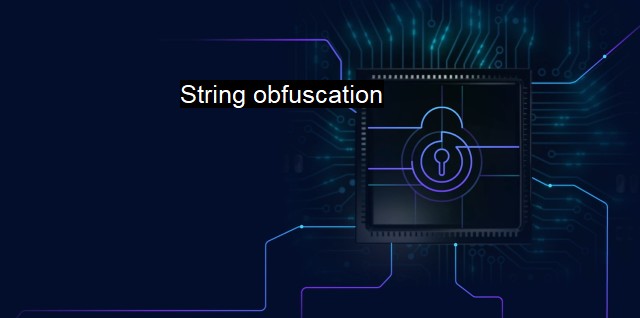What is String obfuscation?
Exploring the Significance of String Obfuscation in Cybersecurity and Antivirus: An Insight into the Method Used by Hackers to Evade Detection
String obfuscation refers to the practice of disguising or concealing the meaning or intent of the code in a software application. string obfuscation serves as a technique that attackers use to prevent their harmful code from being detected. At the same time, it can create problems for cybersecurity professionals attempting to understand how the concealed codes operate. To make things simple, imagine it as a strategy of encoding a secret message where the sender doesn’t want someone to understand or interpret it.The nature of malicious programs involves various executable tasks that readily leave noticeable patterns or recognizable strings in their codes. Antivirus solutions are designed to detect these patterns and alert the system. by using string obfuscation techniques, attackers can mask these patterns, making it difficult for antivirus software to identify the threat, thereby bypassing the system’s security defenses.
String obfuscation implements different methodologies. A common method is ‘Base64 encoding’, where attackers transform their data into a representation that only uses 64 easily printable characters of the ASCII standard. This results in a string that seems meaningless and doesn't raise suspicion. Other methods are ‘XOR operations’ and ‘substitution ciphers’. XOR operation generates a reversible bit stream from the original piece of code that can be used for both encoding and decoding. Substitution ciphers swap individual bits or chunks of the original code with a corresponding foreign bit. Encrypting code strings or hiding them within other inoffensive data (Steganography) are other common practices.
Conversely, string obfuscation can also play a protective role in cybersecurity. It can help safeguard a system by shielding proprietary algorithms and sensitive data contained within the system's code. This practice, known as software or code obfuscation, hinders reverse engineering attempts by making the application code confusing and cumbersome to understand. This protective layer makes it harder for attackers to figure out how the code works, thereby improving resilience against data theft and unauthorized manipulation.
In combating malicious string obfuscation, various sophisticated methods have also emerged. Static and dynamic analysis provides for pre and post-execution analysis of obfuscated codes, respectively. Static analysis searches for abnormalities in the code structure without executing the program, while dynamic analysis uncovers what the code does when executed.
Heuristic analysis adds another layer of protection as it allows the detection of new or unknown threats. It archives previous incidents and patterns of malicious activities and uses an algorithm to predict threats based on this. Machine learning algorithms learn and adapt to obfuscation techniques over time, eventually enabling faster detection and response to threats.
String obfuscation continues to pose a challenge in the world of cybersecurity and antivirus technologies. While it has beneficial applications, its malicious use compounds the difficulties of threat detection and can potentially bypass security measures. Consequently, cybersecurity experts must continually develop more robust and intelligent solutions to keep pace with attackers' tactics. Heuristic analysis, AI, and machine learning represent promising techniques in overcoming these challenges, illuminating cyber threats' landscape with each passing innovation and each discovered vulnerability.

String obfuscation FAQs
What is string obfuscation?
String obfuscation is a technique used in cybersecurity to hide the actual code or content of a string in order to prevent unauthorized access or malicious attacks.Why is string obfuscation important in cybersecurity?
String obfuscation is important in cybersecurity as it adds an additional layer of security to protect sensitive information and prevent hackers from easily understanding the code or content of a string.How does string obfuscation work in antivirus software?
Antivirus software use string obfuscation to encode virus signatures or detection rules so that they cannot be easily understood or manipulated by attackers. This helps to prevent malware from bypassing antivirus detection techniques.What are the different types of string obfuscation techniques used in cybersecurity?
There are various types of string obfuscation techniques used in cybersecurity, such as encryption, encoding, and hashing. These techniques scramble the code or content of a string in different ways, making it difficult for unauthorized users to access or modify the information.| | A | | | B | | | C | | | D | | | E | | | F | | | G | | | H | | | I | | | J | | | K | | | L | | | M | |
| | N | | | O | | | P | | | Q | | | R | | | S | | | T | | | U | | | V | | | W | | | X | | | Y | | | Z | |
| | 1 | | | 2 | | | 3 | | | 4 | | | 7 | | | 8 | | |||||||